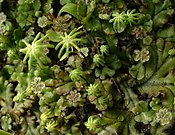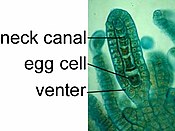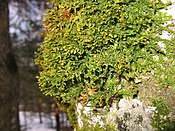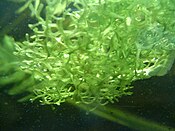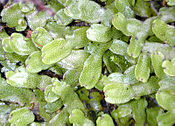Marchantiophyta
| Liverworts | |
|---|---|
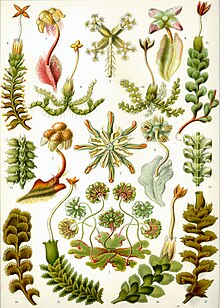
| |
| "Hepaticae" fromErnst Haeckel'sKunstformen der Natur,1904 | |
| Scientific classification | |
| Kingdom: | Plantae |
| Clade: | Embryophytes |
| Clade: | Setaphyta |
| Division: | Marchantiophyta Stotler & Stotl.-Crand., 1977[2]emend. 2000[3] |
| Classes and orders | |
TheMarchantiophyta(/mɑːrˌkæntiˈɒfətə,-oʊˈfaɪtə/) are a division ofnon-vascularland plantscommonly referred to ashepaticsorliverworts.Likemossesandhornworts,they have agametophyte-dominant life cycle, in which cells of the plant carry only a single set of genetic information.
It is estimated that there are about 9000 species of liverworts.[4]Some of the more familiar species grow as a flattened leaflessthallus,but most species are leafy with a form very much like a flattenedmoss.Leafy species can be distinguished from the apparently similar mosses on the basis of a number of features, including their single-celledrhizoids.Leafy liverworts also differ from most (but not all) mosses in that their leaves never have acosta(present in many mosses) and may bear marginalcilia(very rare in mosses). Other differences are not universal for all mosses and liverworts, but the occurrence of leaves arranged in three ranks, the presence of deep lobes or segmented leaves, or a lack of clearly differentiated stem and leaves all point to the plant being a liverwort. Liverworts are distinguished from mosses in having uniquecomplex oil bodiesof high refractive index.
Liverworts are typically small, usually from 2–20 mm (0.079–0.787 in) wide with individual plants less than 10 cm (3.9 in) long, and are therefore often overlooked. However, certain species may cover large patches of ground, rocks, trees or any other reasonably firm substrate on which they occur. They are distributed globally in almost every available habitat, most often in humid locations although there are desert and Arctic species as well. Some species can be a nuisance in shady greenhouses or a weed in gardens.[5]
Physical characteristics[edit]
Description[edit]
Most liverworts are small, measuring from 2–20 millimetres (0.08–0.8 in) wide with individual plants less than 10 centimetres (4 in) long,[6]so they are often overlooked. The most familiar liverworts consist of a prostrate, flattened, ribbon-like or branching structure called athallus(plant body); these liverworts are termedthallose liverworts.However, most liverworts produce flattened stems with overlapping scales or leaves in two or more ranks, the middle rank is often conspicuously different from the outer ranks; these are calledleafy liverwortsorscale liverworts.[7][8](See thegallerybelow for examples.)

Liverworts can most reliably be distinguished from the apparently similarmossesby their single-celledrhizoids.[9]Other differences are not universal for all mosses and all liverworts;[8]but the lack of clearly differentiated stem and leaves in thallose species, or in leafy species the presence of deeply lobed or segmented leaves and the presence of leaves arranged in three ranks,[10][11]as well as frequent dichotomous branching, all point to the plant being a liverwort. Unlike any other embryophytes, most liverworts containunique membrane-bound oil bodiescontaining isoprenoids in at least some of their cells, lipid droplets in the cytoplasm of all other plants being unenclosed.[12]The overall physical similarity of some mosses and leafy liverworts means that confirmation of the identification of some groups can be performed with certainty only with the aid ofmicroscopyor an experiencedbryologist.
Liverworts, like other bryophytes, have agametophyte-dominant life cycle, with thesporophytedependent on the gametophyte.[12]The sporophyte of many liverworts are non-photosynthetic, but there are also several that are photosynthetic to various degrees.[13]Cells in a typical liverwort plant each contain only a single set of genetic information, so the plant's cells arehaploidfor the majority of its life cycle. This contrasts sharply with the pattern exhibited by nearly all animals and by vascular plants. In the more familiarseed plants,the haploid generation is represented only by the tinypollenand theovule,while thediploidgeneration is the familiar tree or other plant.[14]Another unusual feature of the liverwort life cycle is that sporophytes (i.e. thediploidbody) are very short-lived, withering away not long after releasing spores.[15]In mosses, the sporophyte is more persistent and in hornworts, the sporophyte disperses spores over an extended period.[citation needed]
Life cycle[edit]

The life of a liverwort starts from the germination of a haploidsporeto produce aprotonema,which is either a mass of thread-like filaments or a flattened thallus.[16][17]The protonema is a transitory stage in the life of a liverwort, from which will grow the mature gametophore ( "gamete-bearer ") plant that produces the sex organs. The male organs are known asantheridia(singular:antheridium) and produce the sperm cells. Clusters of antheridia are enclosed by a protective layer of cells called theperigonium(plural:perigonia). As in other land plants, the female organs are known asarchegonia(singular:archegonium) and are protected by the thin surroundingperichaetum(plural:perichaeta).[8]Each archegonium has a slender hollow tube, the "neck", down which the sperm swim to reach the egg cell.
Liverwort species may be eitherdioicousormonoicous.In dioicous liverworts, female and male sex organs are borne on different and separate gametophyte plants. In monoicous liverworts, the two kinds of reproductive structures are borne on different branches of the same plant.[18]In either case, the sperm must move from the antheridia where they are produced to the archegonium where the eggs are held. Thespermof liverworts isbiflagellate,i.e. they have two tail-likeflagellaethat enable them to swim short distances,[19]provided that at least a thin film of water is present. Their journey may be assisted by the splashing of raindrops. In 2008, Japanese researchers discovered that some liverworts are able to fire sperm-containing water up to 15 cm in the air, enabling them to fertilize female plants growing more than a metre from the nearest male.[20]
When sperm reach the archegonia,fertilisationoccurs, leading to the production of a diploid sporophyte. After fertilisation, the immaturesporophytewithin the archegonium develops three distinct regions: (1) afoot,which both anchors the sporophyte in place and receives nutrients from its "mother" plant, (2) a spherical or ellipsoidalcapsule,inside which the spores will be produced for dispersing to new locations, and (3) aseta(stalk) which lies between the other two regions and connects them.[19]The sporophyte lacks anapical meristem,anauxin-sensitive point of divergence with other land plants some time in theLate Silurian/Early Devonian.[21][22]When the sporophyte has developed all three regions, the seta elongates, pushing its way out of the archegonium and rupturing it. While the foot remains anchored within the parent plant, the capsule is forced out by the seta and is extended away from the plant and into the air. Within the capsule, cells divide to produce bothelatercells and spore-producing cells. The elaters are spring-like, and will push open the wall of the capsule to scatter themselves when the capsule bursts. The spore-producing cells will undergomeiosisto form haploidsporesto disperse, upon which point the life cycle can start again.
Asexual reproduction[edit]
Some liverworts are capable ofasexual reproduction;in bryophytes in general "it would almost be true to say that vegetative reproduction is the rule and not the exception."[23]For example, inRiccia,when the older parts of the forked thalli die, the younger tips become separate individuals.[23]
Some thallose liverworts such asMarchantia polymorphaandLunularia cruciataproduce small disc-shapedgemmaein shallow cups.[24]Marchantiagemmae can be dispersed up to 120 cm by rain splashing into the cups.[25]InMetzgeria,gemmae grow at thallus margins.[26]Marchantia polymorphais a common weed in greenhouses, often covering the entire surface of containers;[27]: 230 gemma dispersal is the "primary mechanism by which liverwort spreads throughout a nursery or greenhouse."[27]: 231
Symbiosis[edit]
Thalloid liverworts typically harbor symbioticglomeromycetefungi which have arbuscular (cilia-bearing) rootlets resembling those in vascular plants. Species in theAneuraceae,however, associate withbasidiomycetefungi belonging to the genusTulasnella,while leafy liverworts typically harbor symbiotic basidiomycete fungi belonging to the genusSerendipita.[28]
Ecology[edit]
Today, liverworts can be found in many ecosystems across the planet except the sea and excessively dry environments, or those exposed to high levels of direct solar radiation.[29]As with most groups of living plants, they are most common (both in numbers and species) in moist tropical areas.[30]Liverworts are more commonly found in moderate to deep shade, though desert species may tolerate direct sunlight and periods of total desiccation.
Classification[edit]
Relationship to other plants[edit]
Traditionally, the liverworts were grouped together with otherbryophytes(mossesandhornworts) in the Division Bryophyta, within which the liverworts made up the classHepaticae(also called Marchantiopsida).[8][31]Somewhat more recently, the liverworts were given their own division (Marchantiophyta),[32]as bryophytes became considered to beparaphyletic.However, the most recent phylogenetic evidence indicates that liverworts are indeed likely part of a monophyletic clade ( "Bryophytasensu lato"or" Bryophyta Schimp. ") alongside mosses and hornworts.[33][34][35][36][37][38][39][40][41][excessive citations]Hence, it has been suggested that the liverworts should be de-ranked to a class called Marchantiopsida.[35]In addition, there is strong phylogenetic evidence to suggest that liverworts and mosses form a monophyletic subclade namedSetaphyta.[34][42][43]
| 'Monophyletic bryophytes' model | 'Liverworts plus mosses–basal' model | |||||
|---|---|---|---|---|---|---|
| ||||||
| Two of the most likely models for bryophyte evolution.[43] | ||||||
An important conclusion from these phylogenies is that the ancestral stomata appear to have been lost in the liverwort lineage.[34][38]Among the earliestfossilsbelieved to be liverworts arecompression fossilsofPallaviciniitesfrom the UpperDevonianofNew York.[44]These fossils resemble modern species in theMetzgeriales.[45]Another Devonian fossil calledProtosalviniaalso looks like a liverwort, but its relationship to other plants is still uncertain, so it may not belong to the Marchantiophyta. In 2007, the oldest fossils assignable at that time to the liverworts were announced,Metzgeriothallus sharonaefrom theGivetian(MiddleDevonian) ofNew York,United States.[46]However, in 2010, five different types of fossilized liverwort spores were found in Argentina, dating to the much earlier MiddleOrdovician,around 470 million years ago.[1][47]
Internal classification[edit]
Bryologistsclassify liverworts in the divisionMarchantiophyta.This divisional name is based on the name of the most universally recognized liverwort genusMarchantia.[48]In addition to thistaxon-based name, the liverworts are often calledHepaticophyta.This name is derived from their common Latin name as Latin was the language in which botanists published their descriptions of species. This name has led to some confusion,[citation needed]partly because it appears to be a taxon-based name derived from thegenusHepaticawhich is actually aflowering plantof the buttercup familyRanunculaceae.In addition, the name Hepaticophyta is frequently misspelled in textbooks asHepatophyta,which only adds to the confusion.
Although there is no consensus among bryologists as to the classification of liverworts above family rank,[49]the Marchantiophyta may be subdivided into three classes:[50][51][52][53]
- TheJungermanniopsidaincludes the twoordersMetzgeriales(simple thalloids) andJungermanniales(leafy liverworts).
- TheMarchantiopsidaincludes the three ordersMarchantiales(complex-thallus liverworts), andSphaerocarpales(bottle hepatics), as well as theBlasiales(previously placed among the Metzgeriales).[50][54]It also includes the problematic genusMonoclea,which is sometimes placed in its own order Monocleales.[55]
- A third class, theHaplomitriopsidais newly recognized as the sister group of the other liverworts;[53]it comprises the generaHaplomitrium,Treubia,andApotreubia.
| Forrest 2006[50] | Cole, Hilger & Goffinet 2021[56] | |||||||||||||||||||||||||||||||||||||||||||||||||||||||||||||||
|---|---|---|---|---|---|---|---|---|---|---|---|---|---|---|---|---|---|---|---|---|---|---|---|---|---|---|---|---|---|---|---|---|---|---|---|---|---|---|---|---|---|---|---|---|---|---|---|---|---|---|---|---|---|---|---|---|---|---|---|---|---|---|---|---|
|
|
An updated classification by Söderström et al. 2016[57]
- MarchantiophytaStotler & Crandall-Stotler 2000
- HaplomitriopsidaStotler & Crandall-Stotler 1977
- CalobryalesHamlin 1972
- TreubialesSchljakov 1972
- MarchantiopsidaCronquist, Takhtajan & Zimmermann 1966
- BlasiidaeHe-Nygrén et al. 2006
- BlasialesStotler & Crandall-Stotler 2000
- MarchantiidaeEngler 1893 sensu He-Nygrén et al. 2006
- LunularialesLong 2006
- MarchantialesLimpricht 1877(complex thalloids)
- NeohodgsonialesLong 2006
- SphaerocarpalesCavers 1910(bottle liverworts)
- BlasiidaeHe-Nygrén et al. 2006
- JungermanniopsidaStotler & Crandall-Stotler 1977
- JungermanniidaeEngler 1893(leafy liverworts)
- Jungermannialesvon Klinggräff 1858
- PorellalesSchljakov 1972
- PtilidialesSchljakov 1972
- MetzgeriidaeBartholomew-Began 1990
- MetzgerialesChalaud 1930
- PleurozialesSchljakov 1972
- PelliidaeHe-Nygrén et al. 2006
- FossombronialesSchljakov 1972
- PallavicinialesFrey & Stech 2005
- PellialesHe-Nygrén et al. 2006
- JungermanniidaeEngler 1893(leafy liverworts)
- HaplomitriopsidaStotler & Crandall-Stotler 1977
It is estimated that there are about 9000 species of liverworts, at least 85% of which belong to the leafy group.[3][58]Despite that fact, no liverwort genomes have been sequenced to date and only few genes identified and characterized.[59]
Economic importance[edit]
In ancient times, it was believed that liverworts cured diseases of theliver,hence the name.[60]InOld English,the word liverwort literally meansliver plant.[61]This probably stemmed from the superficial appearance of some thalloid liverworts which resemble a liver in outline, and led to the common name of the group ashepatics,from theLatinwordhēpaticusfor "belonging to the liver". An unrelated flowering plant,Hepatica,is sometimes also referred to as liverwort because it was once also used in treating diseases of the liver. This archaic relationship of plant form to function was based in the"Doctrine of Signatures".[62]
Liverworts have little direct economic importance today. Their greatest impact is indirect, through the reduction of erosion along streambanks, their collection and retention of water in tropical forests, and the formation ofsoil crustsin deserts and polar regions. However, a few species are used by humans directly. A few species, such asRiccia fluitans,are aquatic thallose liverworts sold for use inaquariums.Their thin, slender branches float on the water's surface and provide habitat for both small invertebrates and the fish that feed on them.
Gallery[edit]
A small collection of images showing liverwort structure and diversity:
-
Marchantiapolymorpha,with antheridial and archegonial stalks.
-
ThearchegoniumofPorella.
-
A sporophyte ofPorellaemerging from its archegonium.
-
Porellaplatyphyllaclump growing on a tree.
-
Pelliaepiphylla,growing on moist soil.
-
Plagiochilaasplenioides,aleafy liverwort.
-
Riccia fluitans,an aquaticthallose liverwort.
-
Conocephalumconicum,a large thallose liverwort.
See also[edit]
References[edit]
- ^abWalker, Matt. "Fossils of earliest land plants discovered in Argentina"[1].(BBC, Earth News, 2010).
- ^Stotler, Raymond E.; Barbara J. Candall-Stotler (1977). "A checklist of the liverworts and hornworts of North America".The Bryologist.80(3). American Bryological and Lichenological Society: 405–428.doi:10.2307/3242017.JSTOR3242017.
- ^abCrandall-Stotler, Barbara; Stotler, Raymond E. (2000). "Morphology and classification of the Marchantiophyta". In A. Jonathan Shaw; Bernard Goffinet (eds.).Bryophyte Biology.Cambridge: Cambridge University Press. p. 21.ISBN0-521-66097-1.
- ^Liverworts Homepage | UNB
- ^Schuster, Rudolf M. (1992).The Hepaticae and Anthocerotae of North America.Vol. VI. Chicago: Field Museum of Natural History. p. 19.ISBN0-914868-21-7.
- ^Schuster, Rudolf M.The Hepaticae and Anthocerotae of North America,vol. I, pp. 243–244. (New York: Columbia University Press, 1966)
- ^Kashyap, Shiv Ram.Liverworts of the Western Himalayas and the Panjab Plain,vol. I, p. 1. (New Delhi: The Chronica Botanica, 1929)
- ^abcdSchofield, W. B.Introduction to Bryology,pp. 135–140. (New York: Macmillan, 1985).ISBN0-02-949660-8.
- ^Nehira, Kunito. "Spore Germination, Protonemata Development and Sporeling Development", p. 347inRudolf M. Schuster (Ed.),New Manual of Bryology,volume I. (Nichinan, Miyazaki, Japan: The Hattori Botanical Laboratory, 1983).ISBN49381633045.
- ^Allison, K. W. & John Child.The Liverworts of New Zealand,pp. 13–14. (Dunedin: University of Otago Press, 1975).
- ^Conard, Henry S. and Paul L. Redfearn, Jr.How to Know the Mosses and Liverworts,revised ed., pp. 12–23. (Dubuque, Iowa: William C. Brown Co., 1979)ISBN0-697-04768-7
- ^abHarold C. Bold, C. J. Alexopoulos, and T. Delevoryas.Morphology of Plants and Fungi,5th ed., p. 189. (New York: Harper-Collins, 1987).ISBN0-06-040839-1.
- ^Volume 1, Chapter 11-1: Photosynthesis: The Process
- ^Fosket, Donald E.Plant Growth and Development: A Molecular Approach,p. 27. (San Diego: Academic Press, 1994).ISBN0-12-262430-0.
- ^Hicks, Marie L.Guide to the Liverworts of North Carolina,p. 10. (Durham: Duke University Press, 1992).ISBN0-8223-1175-5.
- ^Nehira, Kunito. "Spore Germination, Protonemata Development and Sporeling Development", pp. 358–374inRudolf M. Schuster (Ed.),New Manual of Bryology,volume I. (Nichinan, Miyazaki, Japan: The Hattori Botanical Laboratory, 1983).ISBN49381633045.
- ^Chopra, R. N. & P. K. Kumra.Biology of Bryophytes,pp. 1–38. (New York: John Wiley & Sons, 1988).ISBN0-470-21359-0.
- ^Malcolm, Bill & Nancy Malcolm.Mosses and Other Bryophytes: An Illustrated Glossary,pp. 6 & 128. (New Zealand: Micro-Optics Press, 2000).ISBN0-473-06730-7.
- ^abCampbell, Douglas H.The Structure and Development of Mosses and Ferns,pp. 73–74. (London: The Macmillan Co., 1918)
- ^Pain, S. (2010). "Botanical ballistics".New Scientist.208(2792/3): 45–47.doi:10.1016/s0262-4079(10)63177-6.
- ^Cooke, Todd J; Poli, DorothyBelle; Cohen, Jerry D (2003). "Did auxin play a crucial role in the evolution of novel body plans during the Late Silurian-Early Devonian radiation of land plants?".The Evolution of Plant Physiology.Elsevier.pp. 85–107.doi:10.1016/b978-012339552-8/50006-8.ISBN978-0-12-339552-8.
- ^Friedman, William E.; Moore, Richard C.; Purugganan, Michael D. (2004)."The evolution of plant development".American Journal of Botany.91(10).Botanical Society of America(Wiley): 1726–1741.doi:10.3732/ajb.91.10.1726.ISSN0002-9122.PMID21652320.
- ^abLepp, Heino (15 April 2008)."Vegetative Reproduction".Australian Bryophytes.Australian National Botanic Gardens.Retrieved22 December2011.
- ^Smith, AJE (1989)The Liverworts of Britain and Ireland,Cambridge University Press, Cambridge.
- ^Equihua, C. (1987)."Splash-Cup Dispersal Of Gemmae In The Liverwort Marchantia-Polymorpha".Cryptogamie, Bryologie, Lichénologie.8(3): 199–217. Archived fromthe originalon 26 April 2012.
- ^Lepp, Heino (28 February 2008)."Reproduction & Dispersal".Australian Bryophytes.Australian National Botanic Gardens.Retrieved22 December2011.
- ^abNewby, Adam; Altland, James E.; Gilliam, Charles H.; Wehtje, Glenn (December 2006)."Postemergence Liverwort Control in Container-Grown Nursery Crops1"(PDF).J. Environ. Hort.24(4). Horticultural Research Institute: 230–236. Archived fromthe original(PDF)on 24 July 2012.Retrieved24 December2011.
- ^Bidartondo, Martin I.; Duckett, Jeffrey G. (7 February 2010)."Conservative ecological and evolutionary patterns in liverwort–fungal symbioses".Proceedings of the Royal Society B: Biological Sciences.277(1680): 485–492.doi:10.1098/rspb.2009.1458.PMC2842645.PMID19812075.
- ^Schuster, Rudolf M.The Hepaticae and Anthocerotae of North America,vol. I, pp. 243–249. (New York: Columbia University Press, 1966).
- ^Pócs, Tamás. "Tropical Forest Bryophytes", p. 59inA. J. E. Smith (Ed.)Bryophyte Ecology.(London: Chapman and Hall, 1982).ISBN0-412-22340-6.
- ^Crandall-Stotler, Barbara. & Stotler, Raymond E. "Morphology and classification of the Marchantiophyta". pp. 36–38inA. Jonathan Shaw & Bernard Goffinet (Eds.),Bryophyte Biology.(Cambridge: Cambridge University Press: 2000).ISBN0-521-66097-1
- ^Goffinet, Bernard. "Origin and phylogenetic relationships of bryophytes". pp. 124–149inA. Jonathan Shaw & Bernard Goffinet (Eds.),Bryophyte Biology.(Cambridge: Cambridge University Press:!2000).ISBN0-521-66097-1
- ^Cox, Cymon J.; et al. (2014)."Conflicting Phylogenies for Early Land Plants are Caused by Composition Biases among Synonymous Substitutions".Systematic Biology.63(2): 272–279.doi:10.1093/sysbio/syt109.PMC3926305.PMID24399481.
- ^abcPuttick, Mark N.; et al. (March 2018). "The Interrelationships of Land Plants and the Nature of the Ancestral Embryophyte".Current Biology.28(5): 733–745.e2.Bibcode:2018CBio...28E.733P.doi:10.1016/j.cub.2018.01.063.hdl:1983/ad32d4da-6cb3-4ed6-add2-2415f81b46da.PMID29456145.S2CID3269165.
- ^abde Sousa, Filipe; et al. (2019). "Nuclear protein phylogenies support the monophyly of the three bryophyte groups (Bryophyta Schimp.)".New Phytologist.222(1): 565–575.doi:10.1111/nph.15587.hdl:1983/0b471d7e-ce54-4681-b791-1da305d9e53b.PMID30411803.S2CID53240320.
- ^Leebens-Mack, James H.; et al. (2019)."One thousand plant transcriptomes and the phylogenomics of green plants".Nature.574(7780): 679–685.doi:10.1038/s41586-019-1693-2.PMC6872490.PMID31645766.
- ^Zhang, Jian; et al. (2020)."The hornwort genome and early land plant evolution".Nature Plants.6(2): 107–118.doi:10.1038/s41477-019-0588-4.PMC7027989.PMID32042158.
- ^abHarris, Brogan J.; et al. (2020). "Phylogenomic Evidence for the Monophyly of Bryophytes and the Reductive Evolution of Stomata".Current Biology.30(11): P2201–2012.E2.Bibcode:2020CBio...30E2001H.doi:10.1016/j.cub.2020.03.048.hdl:1983/fbf3f371-8085-4e76-9342-e3b326e69edd.PMID32302587.S2CID215798377.
- ^Li, Fay-Wei; et al. (2020)."Anthoceros genomes illuminate the origin of land plants and the unique biology of hornworts".Nature Plants.6(3): 259–272.doi:10.1038/s41477-020-0618-2.hdl:10261/234303.PMC8075897.PMID32170292.
- ^Sousa, Filipe; et al. (2020)."The Chloroplast Land Plant Phylogeny: Analyses Employing Better-Fitting Tree- and Site-Heterogeneous Composition Models".Frontiers in Plant Science.11:1062.doi:10.3389/fpls.2020.01062.PMC7373204.PMID32760416.
- ^Su, Danyan; et al. (2021)."Large-Scale Phylogenomic Analyses Reveal the Monophyly of Bryophytes and Neoproterozoic Origin of Land Plants".Molecular Biology and Evolution.38(8): 3332–3344.doi:10.1093/molbev/msab106.PMC8321542.PMID33871608.
- ^Sousa, Filipe; et al. (2020)."The mitochondrial phylogeny of land plants shows support for Setaphyta under composition-heterogeneous substitution models".PeerJ.8(4): e8995.doi:10.7717/peerj.8995.PMC7194085.PMID32377448.
- ^abCox, Cymon J. (2018). "Land Plant Molecular Phylogenetics: A Review with Comments on Evaluating Incongruence Among Phylogenies".Critical Reviews in Plant Sciences.37(2–3): 113–127.Bibcode:2018CRvPS..37..113C.doi:10.1080/07352689.2018.1482443.hdl:10400.1/14557.S2CID92198979.
- ^Taylor, Thomas N. & Edith L. Taylor.The Biology and Evolution of Fossil Plants,p. 139. (Englewood Cliffs, NJ: Prentice Hall, 1993).ISBN0-13-651589-4.
- ^Oostendorp, Cora.The Bryophytes of the Palaeozoic and the Mesozoic,pp. 70–71. (Bryophytum Bibliotheca,Band 34, 1987).ISBN3-443-62006-X.
- ^VanAller Hernick, L.; Landing, E.; Bartowski, K.E. (2008). "Earth's oldest liverworts –Metzgeriothallus sharonaesp. nov. from the Middle Devonian (Givetian) of eastern New York, USA ".Review of Palaeobotany and Palynology.148(2–4): 154–162.Bibcode:2008RPaPa.148..154H.doi:10.1016/j.revpalbo.2007.09.002.
- ^Rubinstein, C.V.; Gerrienne, P.; De La Puente, G.S.; Astini, R.A.; Steemans, P. (2010)."Early Middle Ordovician evidence for land plants in Argentina (eastern Gondwana)".New Phytologist.188(2): 365–369.doi:10.1111/j.1469-8137.2010.03433.x.hdl:11336/55341.PMID20731783.
- ^Crandall-Stotler, Barbara. & Stotler, Raymond E. "Morphology and classification of the Marchantiophyta". p. 63inA. Jonathan Shaw & Bernard Goffinet (Eds.),Bryophyte Biology.(Cambridge: Cambridge University Press:2000).ISBN0-521-66097-1
- ^Jones, E. W. (2004).Liverwort and Hornwort Flora of West Africa.Scripta Botnica Belgica. Vol. 30. Meise: National Botanic Garden (Belgium). p. 30.ISBN90-72619-61-7.
- ^abcForrest, Laura L.; Christine E. Davis; David G. Long; Barbara J. Crandall-Stotler; Alexandra Clark; Michelle L. Hollingsworth (2006). "Unraveling the evolutionary history of the liverworts (Marchantiophyta): multiple taxa, genomes and analyses".The Bryologist.109(3): 303–334.doi:10.1639/0007-2745(2006)109[303:UTEHOT]2.0.CO;2.S2CID85912159.
- ^Heinrichs, Jochen; S. Robbert Gradstein; Rosemary Wilson; Harald Schneider (2005). "Towards a natural classification of liverworts (Marchantiophyta) based on the chloroplast gene rbcL".Cryptogamie Bryologie.26(2): 131–150.
- ^He-Nygrén, Xiaolan; Aino Juslén; Inkeri Ahonen; David Glenny; Sinikka Piippo (2006)."Illuminating the evolutionary history of liverworts (Marchantiophyta) – towards a natural classification".Cladistics.22(1): 1–31.doi:10.1111/j.1096-0031.2006.00089.x.PMID34892891.S2CID86082381.
- ^abRenzaglia, Karen S.; Scott Schuette; R. Joel Duff; Roberto Ligrone; A. Jonathan Shaw; Brent D. Mishler; Jeffrey G. Duckett (2007). "Bryophyte phylogeny: Advancing the molecular and morphological frontiers".The Bryologist.110(2): 179–213.doi:10.1639/0007-2745(2007)110[179:BPATMA]2.0.CO;2.S2CID85788756.
- ^Forrest, Laura L.; Barbara J. Crandall-Stotler (2004). "A Phylogeny of the Simple Thalloid Liverworts (Jungermanniopsida, Metzgeriidae) as Inferred from Five Chloroplast Genes".Monographs in Systematic Botany.Molecular Systematics of Bryophytes.98.Missouri Botanical Garden Press: 119–140.
- ^Schuster, Rudolf M.The Hepaticae and Anthocerotae of North America,vol. VI, p. 26. (Chicago: Field Museum of Natural History, 1992).ISBN0-914868-21-7.
- ^Cole, Theodor C. H.; Hilger, Hartmut H.; Goffinet, Bernard."Bryophyte phylogeny poster: systematics and Characteristics of Nonvascular Land Plants (Mosses, Liverworts, Hornworts)".2021.Retrieved6 December2022.
- ^Söderström; et al. (2016)."World checklist of hornworts and liverworts".PhytoKeys(59): 1–826.doi:10.3897/phytokeys.59.6261.PMC4758082.PMID26929706.
- ^Sadava, David; David M. Hillis; H. Craig Heller; May Berenbaum (2009).Life: The Science of Biology(9th ed.). New York: W. H. Freeman. p. 599.ISBN978-1429246446.
- ^Sierocka, I; Kozlowski, L. P.; Bujnicki, J. M.; Jarmolowski, A; Szweykowska-Kulinska, Z (2014)."Female-specific gene expression in dioecious liverwort Pellia endiviifolia is developmentally regulated and connected to archegonia production".BMC Plant Biology.14:168.doi:10.1186/1471-2229-14-168.PMC4074843.PMID24939387.
- ^Dittmer, Howard J.Phylogeny and Form in the Plant Kingdom,p. 286. (Toronto: D. Van Nostrand Co., 1964)
- ^Raven, P. H., R. F. Evert, & S. E. Eichhorn.Biology of Plants,7th ed., p. 351. (New York: W. H. Freeman, 2005).ISBN0-7167-1007-2.
- ^Stern, Kingsley R.Introductory Plant Biology,5th ed., p. 338. (Dubuque, Iowa: Wm. C. Brown Publishers, 1991)ISBN0-697-09947-4.
External links[edit]
 Media related toMarchantiophytaat Wikimedia Commons
Media related toMarchantiophytaat Wikimedia Commons Data related toMarchantiophytaat Wikispecies
Data related toMarchantiophytaat Wikispecies- Liverwort structure in pictures
- LiToL: Assembling the Liverwort Tree of Life(note: for 500,000 million years ago read "480 million years ago".)
- Inter-relationships of Mosses, Liverworts, and Hornworts
- Additional information on Liverworts
- Liverworts

